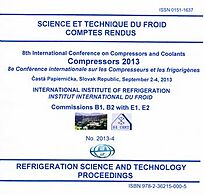
Document IIF
Conception et modélisation des machines à vis.
Design and modelling of screw machines.
Numéro : pap. n. 11
Auteurs : KOVACEVIC A., STOSIC N., RANE S.
Résumé
Positive displacement screw machines are classified as compressors, expanders, blowers, vacuum pumps, liquid and multiphase pumps and used in a variety of applications such as industrial refrigeration, air conditioning and process gas compression. It is estimated that almost 20% of world energy consumption is used for various means of gas compression and pumping. Therefore improvements in the efficiency and robustness of these machines are the imperative for every manufacturer. Screw machines are normally designed with the aid of analytical tools, often based on one-dimensional flow models solved by numerical methods which are validated by experiments. Continuing demands for improvements in accuracy and for designing such machines for new applications have generated a need to use advanced means of assessment of fluid flow within these machines. This paper gives an overview of DISCO© (Design Integration for Screw Compressors), a software tool that parametrically assembles design of screw machines by integrating profile and rotor geometry generation with thermodynamic and CAD design of the machine, taking it further to generate numerical mesh which can then be used for detailed 3D CFD (Computational Fluid Dynamics) analysis. Some of the practical applications of this tool are presented in the paper.
Documents disponibles
Format PDF
Pages : 8 p.
Disponible
Prix public
20 €
Prix membre*
Gratuit
* meilleur tarif applicable selon le type d'adhésion (voir le détail des avantages des adhésions individuelles et collectives)
Détails
- Titre original : Design and modelling of screw machines.
- Identifiant de la fiche : 30008720
- Langues : Anglais
- Source : Compressors 2013: 8th International Conference on Compressors and Coolants.
- Date d'édition : 02/09/2013
Liens
Voir d'autres communications du même compte rendu (60)
Voir le compte rendu de la conférence
Indexation
-
Thèmes :
Compresseurs;
Systèmes de détente - Mots-clés : Vis; Conception; Modélisation; Machine de détente; Compresseur à vis
-
Lessons learned from the modelling of a novel c...
- Auteurs : PEARSON A., FENTON J., SUBERT J.
- Date : 15/07/2022
- Langues : Anglais
- Source : 2022 Purdue Conferences. 26th International Compressor Engineering Conference at Purdue.
- Formats : PDF
Voir la fiche
-
Investigation of the centrifugal force effect t...
- Auteurs : SUBIANTORO A., OOI K. T.
- Date : 16/07/2012
- Langues : Anglais
- Source : 2012 Purdue Conferences. 21st International Compressor Engineering Conference at Purdue.
- Formats : PDF
Voir la fiche
-
Numerical simulation of unsteady flow in a scro...
- Auteurs : GAO H., JIANG Y.
- Date : 14/07/2014
- Langues : Anglais
- Source : 2014 Purdue Conferences. 22nd International Compressor Engineering Conference at Purdue.
- Formats : PDF
Voir la fiche
-
PDSim: a generalized modeling platform to predi...
- Auteurs : ZIVIANI D., ZHANG X., BRAUN J. E., et al.
- Date : 20/07/2017
- Langues : Anglais
- Source : 8th international conference on compressors and refrigeration, 2017.
- Formats : PDF
Voir la fiche
-
Theoretical analysis and experimental validatio...
- Auteurs : DIAO A., TAO J., FENG M., et al.
- Date : 20/07/2017
- Langues : Anglais
- Source : 8th international conference on compressors and refrigeration, 2017.
- Formats : PDF
Voir la fiche
